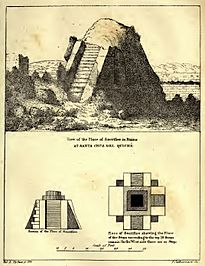Tohil facts for kids
Tohil was a very important god for the Kʼicheʼ Maya. He was worshipped during the later part of the Maya civilization, known as the Late Postclassic period.
When the Spanish arrived, Tohil was the main god for the Kʼicheʼ. He was mostly known as a fire god. But he was also a sun god and a god of rain. Tohil was connected to mountains and was a god of war. He also received special offerings and provided food.
In the Kʼicheʼ epic story, the Popol Vuh, the first people were created. They gathered at a special place called Tollan. There, they received their language and their gods. The Kʼicheʼ people received Tohil there. Tohil asked for special offerings from the Kʼicheʼ. So, they offered their own blood and blood from captives taken in battles.
Tohil might have once been the same god as Qʼuqʼumatz. He shared features with the feathered serpent. But later, they became separate gods with their own priests. Sculptures often showed a human face coming out of a serpent's mouth. This might show Qʼuqʼumatz carrying Tohil, who was like a young sun god, across the sky. Because Tohil was linked to human offerings, the Spanish priests tried to stop his worship after they conquered Guatemala.
Contents
What Tohil Was Known For
People disagree about what the name "Tohil" means. Some think it means "obsidian" (a type of volcanic glass). Others believe it comes from the word toh, meaning "rain." It could also mean "tribute" or "payment."
Tohil was one of three main gods worshipped by the Kʼicheʼ leaders. The other two were Awilix and Jacawitz. Worshipping a group of three gods was an old tradition in Maya religion. It goes back to the Late Preclassic period. Sometimes, all three Kʼicheʼ gods were called Tohil together. Tohil is also linked to God K from the Classic Period. He also shares traits with Mixcoatl, a hunting god of the Aztecs.
Tohil was the special god of the Kaweq family line of the Kʼicheʼ. He was linked to a sacred bundle made of deerskin. This bundle was believed to hold his spirit. One of his titles was Qajawal Kej, which means "Our Lord Deer." Tohil was also connected to thunder, lightning, and the sunrise.
How Tohil Was Worshipped
The Kaweq family built a temple for Tohil at their first capital, Jacawitz. This site is now known as Chitinamit. A shrine to Tohil, called Pa Tohil, was placed on a nearby mountain peak. Later, the Kʼicheʼ built their main temple to Tohil at Qʼumarkaj, their new capital city.
They made offerings to Tohil on the day Toh. This was one of the days in their 20-day calendar cycle. The Kʼicheʼ also performed the Great Dance of Tohil. This dance honored the god in the month of Tzʼikin Qʼij. It happened before the maize (corn) harvest, usually in November. This dance took place at Qʼumarkaj. All the important families under the Kʼicheʼ Kingdom gathered. They were expected to bring gifts, workers, and offerings, as described in the Kʼicheʼ story Título de Totonicapán.
The priests of Tohil were called Aj Tohil. They were chosen from the ruling Kaweq family of Qʼumarkaj. During their ceremonies, the Kʼicheʼ offered quetzal feathers to Tohil. A writer named Francisco Ximénez described in the late 1600s that people were tied at the temple for special offerings to Tohil. After these offerings, the body was likely thrown down the temple's front stairs.
Other groups related to the Kʼicheʼ also worshipped gods similar to Tohil. The Kaqchikels worshipped Belehe Toh. The Rabinal worshipped Hun Toh, which means "One Rain." These groups believed their gods were the same as Tohil, just with different names. The Kʼicheʼ themselves said in the Popol Vuh that their god Tohil was the same as Quetzalcoatl of the Aztecs.
Temple of Tohil at Qʼumarkaj
The Temple of Tohil at Qʼumarkaj was the tallest building in the city. The inner part of the building still stands. But its stone outer layer has been taken away over time. The temple was originally a pyramid with stairs on all four sides. The shrine at the top faced the rising sun in the east. This type of pyramid temple was built by the Maya since the Late Preclassic period. Examples can be seen at sites like Tikal, Copán, and Chichen Itza.
According to John Lloyd Stephens, who visited in the 1830s, the temple base was about 66 feet (20 meters) square. It stood 33 feet (10 meters) high. At that time, the stairs on all sides were mostly still there. The temple was once covered in painted stucco (a type of plaster). Its decorations included a painted image of a jaguar.
Tohil's Influence Today
Deerskins, which were a symbol of Tohil, are still honored in many Maya communities in the highlands today. They are used in dances. In the modern village of Santiago Atitlán in the Guatemalan highlands, traditional Maya priests perform rituals. They honor a powerful god called "King Martin, Lord of the Three Levels, Lord of Rain, Lord of Maize, and Lord of all the Mountains."
This priest blesses deerskins before they are worn. People wear them with a deer head and antlers attached. This happens during the Dance of Martin on November 11, before the corn harvest. King Martin is likely a mix of Tohil and his deerskin symbol. He is also blended with the Roman Catholic Saint Martin of Tours. Saint Martin's feast day is on the same date. In Rabinal, Tohil was combined with Saint Paul. But he still kept many of his original features.
See also
 In Spanish: Tohil para niños
In Spanish: Tohil para niños



